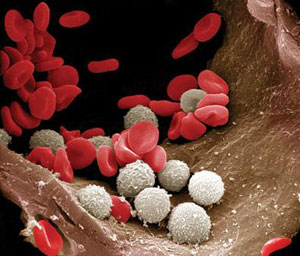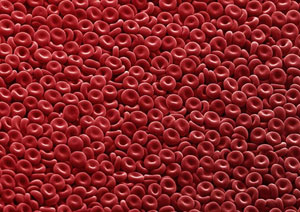 Many needs in all living things—such as carrying nourishment and gasses like oxygen to the cells, and eliminating waste products from the body—are met by substances carried by the circulatory system. In human beings, the liquid that performs all these functions is the blood. Every single cell in your body, from a skin cell on your fingertip to the specialized retinal cells in your eyes, depends on what blood provides.
Many needs in all living things—such as carrying nourishment and gasses like oxygen to the cells, and eliminating waste products from the body—are met by substances carried by the circulatory system. In human beings, the liquid that performs all these functions is the blood. Every single cell in your body, from a skin cell on your fingertip to the specialized retinal cells in your eyes, depends on what blood provides.
Blood flows through the arteries and veins that interpenetrate the body like a transport network or river delta, visiting every single corner of the body. During its travels through the arteries, that river carries numerous substances that the cells require. We can think of these as cargo packages carried by the river, containing food, water and various chemical substances. The most urgent package to be delivered is oxygen, because if deprived of oxygen, cells will soon die. Thanks to the specially constructed system in your body, however, the packages are delivered to every cell in time and to the correct “addresses.”
You seldom feel the flowing of this river during the course of your day-to-day life. However, the human body has been created with such a consummate artistry that though everywhere is interpenetrated by blood vessels, they are invisible from the outside. That is because the 2-mm (0.07-inch) layer of skin that covers your body conceals the capillaries in a masterly fashion.
That epidermal layer is actually so thin that the slightest scratch will cause some blood to leak through it. Were the vessels not covered by a very fine and attractive skin, there is no doubt that even the most attractive people in the world would appear hideously repellent.
Blood performs a great number of vital functions inside the body, such as carrying waste and toxic substances to the liver, supporting the immune system, regulating body temperature rather like an air-conditioning unit, and carrying nutriments to the relevant regions. Communication via hormones within the body is also performed almost entirely by the blood.
Blood’s vital and inimitable features
1. Responsibility for transportation
Substances of all kinds that the body requires are carried to the relevant organs by the blood. Nutrients such as glucose, amino acids and minerals—and most importantly, oxygen—are just a few of these. In addition, the blood works like a waste disposal system, collecting unwanted substances from every cell. And each of the 100 trillion or so cells in the body produces waste products as a result of its daily functions. These waste products, including such potentially toxic compounds as carbon dioxide and urea, are removed from the cells by means of the bloodstream. The blood carries the non-gaseous wastes to the kidneys, where they are distilled. The carbon dioxide produced in the cells is carried to the lungs, from where it is expelled from the body.
Blood cells moving in veins It is unconscious blood cells that do all this. However, these cells can, in a very conscious manner, distinguish between waste and useful substances carried in the blood, and know which are to be deposited where. For example, they never carry toxic gasses to the kidneys, nor metabolic by-products to the lungs. Neither do they send waste products to any organ in need of nutrients— an error that would lead to the death of the entire body. The blood cells perform their functions with no confusion, error, misunderstanding or deficiency, in a most conscious manner, indicating the existence of a Mind and Consciousness that controls, regulates and organizes them. That cannot be the human being in question, because people live their entire lives quite unaware of these processes. Yet the circulation system continues to function, and flawlessly. To claim that the blood cells acquired their ability to distinguish, select and decide by chance, and that they do these things of their own will, would be totally illogical and irrational. It is Allah, the Almighty, Who gave the blood these features and created this flawless system.
It is unconscious blood cells that do all this. However, these cells can, in a very conscious manner, distinguish between waste and useful substances carried in the blood, and know which are to be deposited where. For example, they never carry toxic gasses to the kidneys, nor metabolic by-products to the lungs. Neither do they send waste products to any organ in need of nutrients— an error that would lead to the death of the entire body. The blood cells perform their functions with no confusion, error, misunderstanding or deficiency, in a most conscious manner, indicating the existence of a Mind and Consciousness that controls, regulates and organizes them. That cannot be the human being in question, because people live their entire lives quite unaware of these processes. Yet the circulation system continues to function, and flawlessly. To claim that the blood cells acquired their ability to distinguish, select and decide by chance, and that they do these things of their own will, would be totally illogical and irrational. It is Allah, the Almighty, Who gave the blood these features and created this flawless system.
2. Troop Carrying
Another of the blood’s duties is to carry the cells of the immune system that fight disease. Any foreign bodies like viruses and bacteria that enter the body are neutralized by the antibodies and leucocytes in the blood. In addition, immune system cells patrol the bloodstream and so monitor the entire body. (For more details, see The Miracle of the Immune System by Harun Yahya.)
3. Communications
An immune-system cell patrolling the blood vessels
The blood also constitutes one of the body’s main avenues of communication. There is a magnificent communications system among the cells in the human body. They exchange information with one another, just as if each one were truly conscious. The cells send to one another chemical messages in the form of hormones, carried by the blood. (For details, see the chapter on “Splendid Communication within the Body: The Hormonal System.”)
4. Wound Healing
One of the blood’s most miraculous features is its clotting mechanism. Thanks to this clotting, or coagulation, blood loss from a damaged vessel is reduced to the minimum possible. During the clotting process, dozens of proteins, enzymes and vitamins serve in regimented order. Because of this feature, scientists have shown the clotting mechanism as an example of flawless planning. (For details, see pp. 41-47)
5. The Regulation of Balances Within the Body
One of the vital cargo packages carried by the blood is heat. Arteries filled with blood spread heat through the body, just like the piping that carries hot water throughout a building. But unlike the pipes in a building, the body’s heat source is not a single boiler, but all the many cells in the body. Thanks to the blood, heat produced by each cell is distributed equally to all the others.
Were there no heat distribution system in your body, you would experience grave problems. As the result of any muscular activity you perform—running for instance, or carrying a heavy load—your legs or arms would overheat, and other regions of your body would remain close to room temperature—an imbalance that would inflict serious damage on your metabolism. For that reason, the equal distribution of heat is of the greatest importance. In the same way, the blood again goes into action along with the sweat glands in order to reduce excessive heat. Blood vessels under the skin dilate, making it easier for heat carried in the blood to be released to the air. When we engage in strenuous physical activity, therefore, your face grows flushed because of blood vessel dilation. Blood also plays an important role in keeping your body temperature from cooling off. When you feel cold, your skin turns paler, because blood vessels under the skin contract according to the chill in the air. The quantity of blood in those regions close to the air is therefore reduced, and heat loss from within the body is reduced to a minimum.
In the same way, the blood again goes into action along with the sweat glands in order to reduce excessive heat. Blood vessels under the skin dilate, making it easier for heat carried in the blood to be released to the air. When we engage in strenuous physical activity, therefore, your face grows flushed because of blood vessel dilation. Blood also plays an important role in keeping your body temperature from cooling off. When you feel cold, your skin turns paler, because blood vessels under the skin contract according to the chill in the air. The quantity of blood in those regions close to the air is therefore reduced, and heat loss from within the body is reduced to a minimum.
(Harun Yahya, The Human Miracle)
TOPICS
VaticanSocialismIlluminationFrench RevolutionConvertSabbateanJacobinismMasonic MediaPolitical ZionismYoung TurkThe Committee of Union and ProgressAbdulhamidAnti-NaziWorld Zionist Organization Nuremberg LawsMussoliniWorld War IAdolf EichmannGoyimThe Rothschild DynastyThink-ThankCFRRockefellerCold WarStalinOctober RevolutionSoviet UnionBilderbergVietnamAIPACLobbyfairSoutheastGreeceNew World OrderRed Seageopoliticsveterantaxcustoms2023antelopebullEurasia Islam CouncilNobel PrizeHospitalSocial Security InstitutionAli BabacanTurgut OzalassassinationGaffar OkkanMuhsin YazıcıoğluRosetta NebulaAstronomyRose


